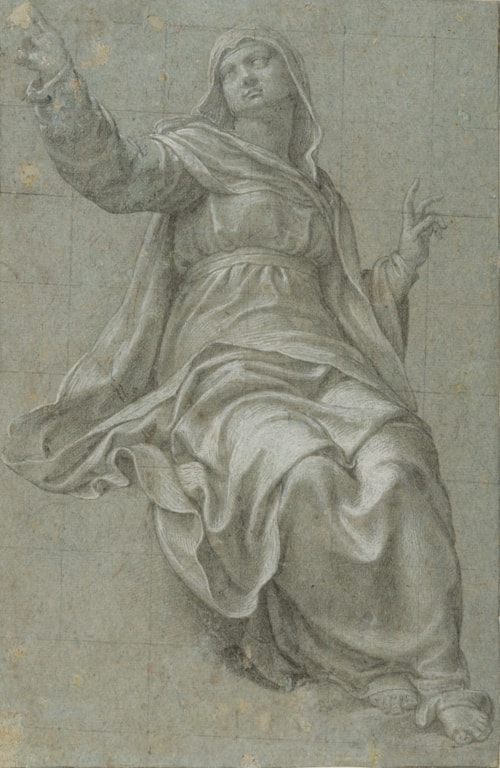
Girolamo SICIOLANTE DA SERMONATA
Sermoneta c.1521 - Rome 1575
Biography
Born in the hill town of Sermoneta, southeast of Rome, Girolamo Siciolante joined the Roman studio of Perino del Vaga around 1541, the same year as his earliest known painting, an altarpiece for a small church near his home town. Siciolante entered the Accademia di San Luca in Rome in 1543, and at around the same time painted his first significant work; a Pietà for the Roman church of Santi Apostoli that is now in the Muzeum Narodowe in Poznan, Poland. By 1544 he was working as an assistant to Perino del Vaga on the fresco decoration of the Castel Sant’Angelo, mainly in the Sala Paolina. However, as Marcia Hall has noted of the artist, ‘his temperament did not dispose him to sympathy with Perino’s ornate style. He seems from the start to have been predisposed to the direct expression of religious feeling.’ After working briefly at the ducal court of Pier Luigi Farnese in Parma, he travelled to Bologna, where in 1548 he painted a Madonna and Child with Saints for the high altar of the church of San Martino Maggiore. A few months after Perino’s death in October 1547, Siciolante returned to Rome to work on some of the master’s unfinished projects, notably a fresco of The Baptism of Clovis in the church of San Luigi dei Francesi, completed by 1549. Of around the same date is the decoration of the Caetani chapel in the church of San Giuseppe in the artist’s native Sermoneta, commissioned by his longtime patrons, the Caetani family, as well as a series of paintings for the chapel of the Chateau de la Bastie d’Urfé in France, ordered by the French ambassador to the papal court, Claude d’Urfé. Relatively little is known of Siciolante’s career during the decade of the 1550s, and no works survive from this period, with the possible exception of a fresco cycle in the Palazzo Spada in Rome, which has been dated to the beginning of the decade. An altarpiece commissioned by Pope Julius II for the Roman church of Sant’Andrea in Via Flaminia, for which the artist received payment in 1553, was severely damaged by the flooding of the Tiber four years later.
Unlike his teacher Perino del Vaga and many of his Roman contemporaries, Siciolante seems to have been uninterested in competing for secular decorative commissions. Nevertheless, his somewhat conservative style as a painter found considerable success in post-Tridentine Rome. The 1560s and 1570s saw the artist at the forefront of artistic activity in the city, working in the Vatican and in churches throughout Rome and its environs, as well as receiving numerous private commissions from noble Roman families and members of the papal court. Among the more significant works of his later career were the decoration of the Fugger chapel in the church of Santa Maria dell’Anima and a fresco of The Donation of Pepin for the Sala Regia of the Vatican, commissioned from the artist in 1565. He also produced important paintings for the Roman churches of Santa Maria Maggiore, San Tomaso ai Cenci, Santa Maria in Aracoeli and Santa Maria sopra Minerva, as well as the Basilica of Saint Peter. Twice elected by his peers to head the Accademia di San Luca, by the time of his death in 1575 Siciolante was one of the most prominent and successful painters in Rome, although he left no school or influenced any significant followers.
While Siciolante enjoyed a fruitful career that lasted some four decades, only a relatively few drawings by the artist, numbering less than thirty sheets, are known today. While his early drawings are strongly influenced by the example of Perino del Vaga’s pen draughtsmanship, his mature figure studies in black chalk, of which the present sheet is a particularly fine example, reflect the abiding influence of Michelangelo’s late work in Rome.


